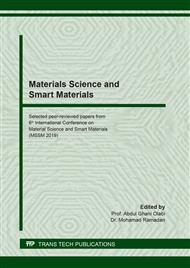p.1
p.7
p.13
p.19
p.25
p.31
p.37
p.43
Effect of Electron Beam Irradiation on the Rheological Properties and Phase Transition Temperature of Poly(N-Vinylcaprolactam)
Abstract:
Exposing smart materials to electron beam radiation can induce free radical reactions, such as chain branching or crosslinking, hence enhancing the characteristics of the polymers. Poly (N-vinylcaprolactam) (PNVCL) is a smart material which was synthesised by photopolymerisation. Subsequently, samples were exposed to electron beam technology, where electron beam irradiation was utilised in a novel approach. This led to the modification of the rheological and phase transition properties. Modifying PNVCL through electron beam irradiation opens new avenues and potential applications in the biomedical field. Physically cross-linked PNVCL polymers were prepared by photopolymerisation and samples were subsequently irradiated at different dose ranges (5kGy, 25kGy and 50 kGy). The rheological properties of the PNVCL based samples were established by rheological analysis. Similarly, the PNVCL based sample polymers were further characterised in solution to determine the phase transition of PNVCL.
Info:
Periodical:
Pages:
19-24
Citation:
Online since:
September 2020
Price:
Сopyright:
© 2020 Trans Tech Publications Ltd. All Rights Reserved
Share:
Citation:


